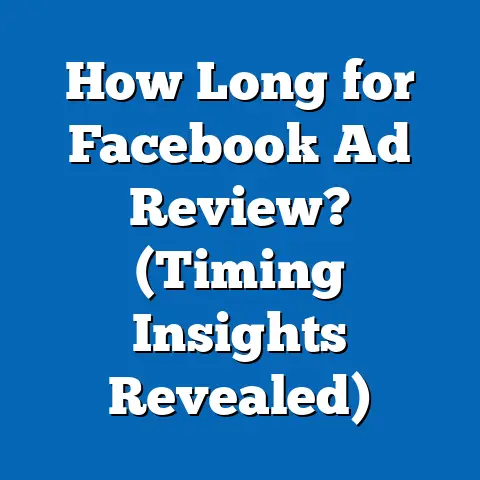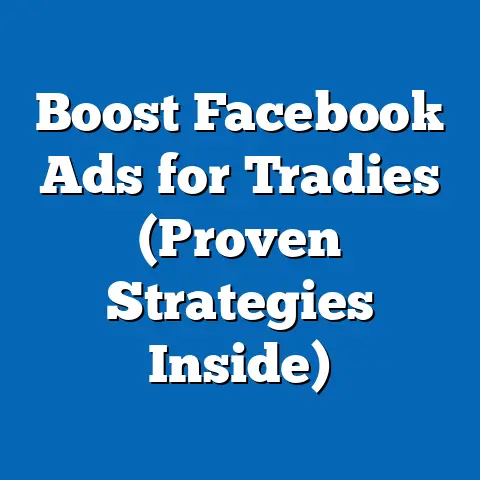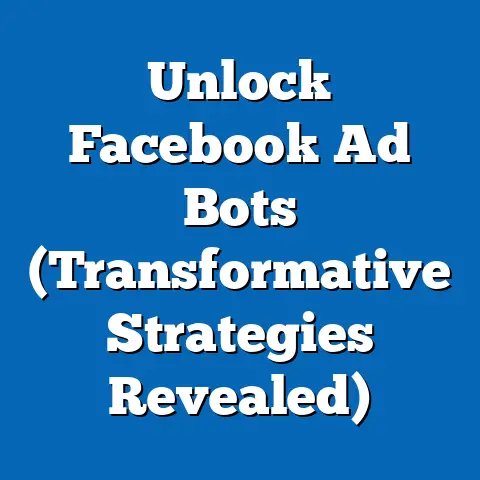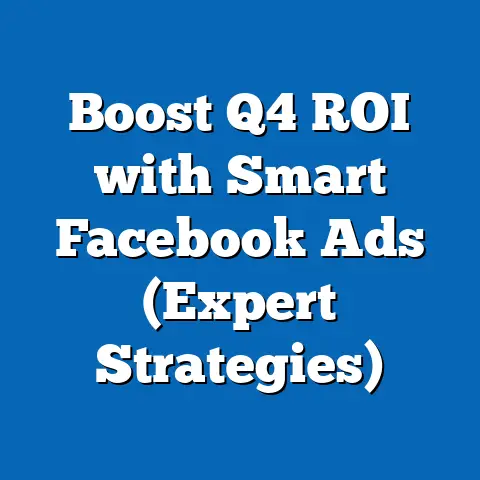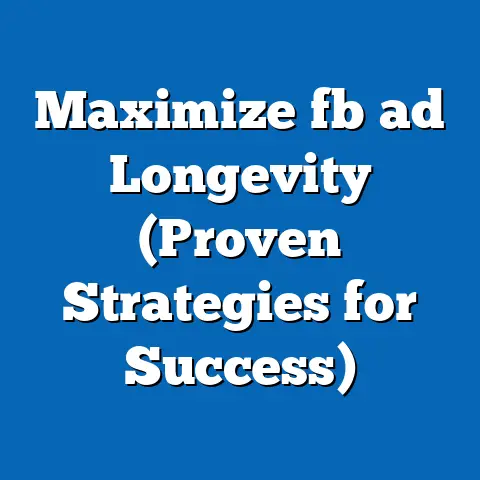Mastering Facebook Ad Parameters (Expert Insights Unveiled)
Have you ever scrolled through Facebook and wondered why some ads grab your attention instantly while others fade into the background? It’s not just luck. Mastering Facebook ad parameters is the key to unlocking a world of successful campaigns, and I’m here to show you how. Through years of experience managing Facebook ad campaigns for diverse businesses, I’ve learned that the devil is truly in the details. Understanding and optimizing these parameters is the difference between wasting your ad budget and achieving exponential growth.
Understanding Facebook Ad Parameters
Facebook ad parameters are the settings and choices you make when creating and managing your ad campaigns. Think of them as the dials and levers that control who sees your ads, where they see them, and how much you spend to reach them. These parameters significantly impact your ad’s targeting, reach, and engagement. Without a solid grasp of these elements, your ads might as well be shouting into the void.
Why are these parameters so important? Well, they directly influence your ability to connect with the right audience, maximize your budget, and ultimately achieve your advertising goals. From carefully selecting your target audience to choosing the right bid strategy, every parameter plays a crucial role in determining the success of your campaign.
Some of the key parameters you need to know include:
- Audience Targeting: Who are you trying to reach?
- Ad Placement: Where will your ads appear?
- Bid Strategy: How much are you willing to pay?
- Ad Formats: What type of ad will you create?
Let’s dive into each of these in detail to unlock the secrets to Facebook advertising mastery.
Deep Dive into Key Ad Parameters
Audience Targeting
One of the most powerful features of Facebook advertising is its ability to target specific audiences. Unlike traditional advertising, where you cast a wide net and hope to catch a few fish, Facebook allows you to laser-focus your efforts on the people most likely to be interested in your product or service.
Demographics, Interests, and Behaviors
Facebook offers a wealth of targeting options based on demographics, interests, and behaviors.
- Demographics: This includes factors like age, gender, location, education, and job title. For instance, if you’re selling baby products, you can target new parents within a specific age range and geographic area.
- Interests: This allows you to reach people based on their hobbies, passions, and the things they like on Facebook. If you’re promoting a fitness program, you can target people interested in health, wellness, and specific types of exercise.
- Behaviors: This targets people based on their purchase behaviors, device usage, and other online activities. For example, you can target people who frequently make online purchases or those who use specific types of mobile devices.
Custom Audiences vs. Lookalike Audiences
Beyond these basic targeting options, Facebook also offers two powerful tools: Custom Audiences and Lookalike Audiences.
- Custom Audiences: These allow you to upload your own data (like email lists or customer lists) to create targeted audiences. This is incredibly useful for retargeting existing customers or reaching people who have already shown interest in your brand. I once used a custom audience to target past customers with a special offer, resulting in a 30% increase in sales.
- Lookalike Audiences: These allow you to create new audiences that resemble your existing customers or website visitors. Facebook analyzes the characteristics of your source audience and finds new people who share similar traits. This is a great way to expand your reach and find new potential customers. I’ve found that lookalike audiences often outperform broad targeting options, leading to higher conversion rates and lower costs per acquisition.
Expert Tips for Segmenting Audiences
To get the most out of your audience targeting, it’s essential to segment your audiences based on specific criteria. This allows you to tailor your ad messaging and creative to resonate with different groups of people.
- Segment by Customer Stage: Target people at different stages of the customer journey with different messages. For example, you can target people who are aware of your brand with informational content and those who are ready to buy with promotional offers.
- Segment by Product Category: If you sell multiple products, segment your audience based on their interests in specific product categories. This allows you to show them ads for the products they’re most likely to be interested in.
- Segment by Engagement Level: Target people who have engaged with your content in the past with more personalized ads. For example, you can target people who have watched your videos with ads that offer a free trial or discount.
Takeaway: Effective audience targeting is the foundation of a successful Facebook ad campaign. By understanding the various targeting options and segmenting your audiences, you can ensure that your ads reach the right people and deliver the right message.
Ad Placement
Ad placement refers to where your ads appear on Facebook and its related platforms. Facebook offers a variety of placement options, each with its own unique characteristics and benefits.
Different Ad Placement Options
- Facebook Feed: This is the most common ad placement, appearing directly in users’ news feeds alongside organic content. Feed ads are highly visible and can be very effective for driving engagement and conversions.
- Instagram Feed: Similar to the Facebook feed, Instagram feed ads appear in users’ Instagram feeds. This placement is ideal for visually appealing ads that resonate with Instagram’s younger audience.
- Facebook Stories: These are short, vertical videos or images that appear at the top of the Facebook app. Stories ads are great for capturing attention and driving quick actions, like visiting a website or making a purchase.
- Instagram Stories: Similar to Facebook Stories, Instagram Stories ads appear in users’ Instagram Stories. This placement is particularly effective for reaching younger audiences and driving engagement.
- Facebook Marketplace: This placement appears in the Facebook Marketplace, where users buy and sell items. Marketplace ads are ideal for promoting products and services to people who are actively looking to make a purchase.
- Facebook Right Column: These ads appear in the right column of the Facebook website. Right column ads are less visually prominent than feed ads but can still be effective for driving traffic to your website.
- Audience Network: This allows you to extend your reach beyond Facebook and Instagram to a network of third-party websites and apps. Audience Network ads can be a cost-effective way to reach a broader audience.
Testing Placements and Optimizing Based on Performance Metrics
It’s important to test different ad placements to see which ones perform best for your specific campaign goals. Not all placements are created equal, and what works for one business may not work for another.
I’ve found that the best way to determine the optimal placement strategy is to run A/B tests with different combinations of placements. Track key metrics like click-through rate (CTR), cost per click (CPC), and conversion rate to see which placements are driving the best results.
For example, if you’re running a lead generation campaign, you might find that Facebook Feed ads have a higher conversion rate than Audience Network ads. In that case, you would want to allocate more of your budget to the Facebook Feed placement.
Choosing Placements Based on Campaign Goals
The best ad placement strategy depends on your specific campaign goals.
- Brand Awareness: For brand awareness campaigns, you might want to focus on placements with high reach, like Facebook Feed, Instagram Feed, and Audience Network.
- Website Traffic: For driving traffic to your website, you might want to focus on placements with high click-through rates, like Facebook Feed and Instagram Stories.
- Lead Generation: For lead generation campaigns, you might want to focus on placements with high conversion rates, like Facebook Feed and Facebook Marketplace.
- Sales: For driving sales, you might want to focus on placements that target people who are actively looking to make a purchase, like Facebook Marketplace and Instagram Shopping.
Takeaway: Don’t assume that all ad placements are created equal. Test different placements, track your results, and optimize your strategy based on performance metrics. Choose placements that align with your specific campaign goals to maximize your ROI.
Bid Strategy
Your bid strategy determines how much you’re willing to pay to show your ads to your target audience. Facebook offers a variety of bidding options, each with its own advantages and disadvantages.
Different Bidding Options
- Lowest Cost: This bidding option aims to get you the most results for your budget. Facebook will automatically bid on your behalf to find the lowest cost opportunities. This is a good option for beginners or those who want to maximize their budget.
- Target Cost: This bidding option allows you to set a target cost per result. Facebook will then try to achieve that cost while delivering as many results as possible. This is a good option for those who have a specific cost target in mind.
- Cost Cap: This bidding option allows you to set a maximum cost per result. Facebook will never bid above your cost cap, even if it means delivering fewer results. This is a good option for those who want to control their costs and avoid overspending.
- Manual Bidding: This bidding option gives you complete control over your bids. You can set your own bids for each auction and adjust them manually based on performance. This is a good option for experienced advertisers who want to optimize their bids for maximum ROI.
When to Use Each Bidding Strategy
The best bidding strategy depends on your specific campaign goals and budget.
- Lowest Cost: Use this strategy when you want to maximize your results for a limited budget. It’s a good starting point for new campaigns.
- Target Cost: Use this strategy when you have a specific cost target in mind and want to maintain a consistent cost per result.
- Cost Cap: Use this strategy when you want to control your costs and avoid overspending, even if it means sacrificing some results.
- Manual Bidding: Use this strategy when you have experience optimizing bids and want to maximize your ROI by fine-tuning your bids based on performance data.
Understanding CPA and ROAS
Two key metrics to understand when choosing your bidding strategy are Cost Per Acquisition (CPA) and Return on Ad Spend (ROAS).
- CPA: This is the cost of acquiring a new customer through your advertising efforts. It’s calculated by dividing your total ad spend by the number of new customers you acquired.
- ROAS: This is the return on your ad spend. It’s calculated by dividing your revenue generated from your ads by your total ad spend.
Understanding these metrics will help you determine whether your bidding strategy is effective and whether you’re getting a good return on your investment. I always tell my clients, “It’s not about how much you spend, it’s about how much you make.”
Takeaway: Your bid strategy is a critical component of your Facebook ad campaign. Choose the right bidding strategy based on your goals and budget, and always track your CPA and ROAS to ensure that you’re getting a good return on your investment.
Ad Formats and Creative Elements
Your ad format and creative elements are the visual and textual components of your ad. These elements play a crucial role in capturing attention, conveying your message, and driving engagement.
Various Ad Formats
- Image Ads: These are simple ads that consist of an image, headline, and description. Image ads are great for showcasing your products or services in a visually appealing way.
- Video Ads: These are ads that consist of a video, headline, and description. Video ads are great for capturing attention and telling a story. I’ve seen video ads generate significantly higher engagement rates than image ads, especially for complex products or services.
- Carousel Ads: These ads allow you to showcase multiple images or videos in a single ad. Carousel ads are great for highlighting different features of your product or service or telling a story in a series of images or videos.
- Collection Ads: These ads are designed to showcase a collection of products. Collection ads are great for driving sales and increasing average order value.
- Instant Experience Ads: These are full-screen, mobile-optimized ads that load instantly when clicked. Instant Experience ads are great for creating immersive experiences and driving engagement.
Impact of Visuals, Copy, and Call-to-Action
The creative elements of your ad, such as visuals, copy, and call-to-action, play a crucial role in determining its effectiveness.
- Visuals: Your visuals should be high-quality, visually appealing, and relevant to your target audience. Use images or videos that capture attention and convey your message effectively.
- Copy: Your ad copy should be clear, concise, and compelling. Highlight the benefits of your product or service and tell a story that resonates with your target audience.
- Call-to-Action: Your call-to-action (CTA) should be clear and actionable. Tell people exactly what you want them to do, whether it’s visiting your website, making a purchase, or signing up for your email list.
Best Practices for Creating Compelling Ad Creatives
- Know Your Audience: Understand your target audience and create ads that resonate with their interests and needs.
- Keep It Simple: Avoid cluttering your ads with too much text or too many images. Keep your message clear and concise.
- Use High-Quality Visuals: Use high-resolution images or videos that are visually appealing and relevant to your message.
- Tell a Story: Use your ad copy to tell a story that captures attention and engages your audience.
- Use a Clear Call-to-Action: Tell people exactly what you want them to do and make it easy for them to take action.
- Test Different Creatives: Run A/B tests with different visuals, copy, and CTAs to see what works best for your target audience.
Takeaway: Your ad format and creative elements are crucial for capturing attention, conveying your message, and driving engagement. Experiment with different ad formats and creative elements to find what works best for your target audience.
The Role of Analytics in Ad Parameter Mastery
Mastering Facebook ad parameters is not a one-time effort. It requires continuous monitoring, analysis, and optimization. This is where Facebook Ads Manager comes in.
Facebook Ads Manager and Key Metrics
Facebook Ads Manager is your central hub for creating, managing, and analyzing your ad campaigns. It provides a wealth of data and insights that can help you refine your ad parameters and boost performance.
Some of the key metrics to track in Facebook Ads Manager include:
- Reach: The number of people who saw your ads.
- Impressions: The number of times your ads were displayed.
- Click-Through Rate (CTR): The percentage of people who clicked on your ads.
- Cost Per Click (CPC): The average cost of each click on your ads.
- Conversion Rate: The percentage of people who completed a desired action (like making a purchase or signing up for your email list) after clicking on your ads.
- Cost Per Acquisition (CPA): The cost of acquiring a new customer through your advertising efforts.
- Return on Ad Spend (ROAS): The return on your ad spend.
Interpreting Data to Refine Ad Parameters
By tracking these metrics, you can gain valuable insights into the performance of your ad campaigns and identify areas for improvement.
For example, if you notice that your CTR is low, it might indicate that your ad copy or visuals are not compelling enough. If your CPA is high, it might indicate that your targeting is too broad or that your bidding strategy is not optimal.
A/B Testing and Iterative Optimization
A/B testing is a powerful tool for optimizing your ad campaigns. It involves creating two versions of an ad with slight variations (like different headlines, visuals, or CTAs) and testing them against each other to see which one performs better.
By running A/B tests, you can iteratively optimize your ad parameters and improve your campaign performance over time. I always recommend starting with small A/B tests, focusing on one variable at a time, to get clear insights into what’s working and what’s not.
Takeaway: Analytics are essential for mastering Facebook ad parameters. Use Facebook Ads Manager to track key metrics, interpret data, and run A/B tests to continuously optimize your campaigns.
Common Mistakes and How to Avoid Them
Even experienced advertisers can make mistakes when setting up Facebook ad parameters. Here are some common pitfalls to avoid:
- Broad Targeting: Targeting too broad of an audience can result in wasted ad spend and low conversion rates. Be specific and laser-focus your targeting on the people most likely to be interested in your product or service.
- Ignoring Placement Optimization: Neglecting to test and optimize ad placements can result in poor performance. Test different placements and allocate your budget to the ones that are driving the best results.
- Setting It and Forgetting It: Assuming that your ad parameters are set in stone can lead to missed opportunities for improvement. Continuously monitor your campaigns, analyze your data, and make adjustments as needed.
- Not Testing Creatives: Failing to test different ad creatives can result in missed opportunities to improve engagement and conversions. Run A/B tests with different visuals, copy, and CTAs to see what works best for your target audience.
- Ignoring Ad Relevance Diagnostics: Facebook provides an “ad relevance diagnostics” score for each ad. Pay attention to this score, as it can provide valuable insights into how well your ad is resonating with your target audience.
Takeaway: Avoid these common mistakes by being specific with your targeting, optimizing your ad placements, continuously monitoring your campaigns, testing different ad creatives, and paying attention to ad relevance diagnostics.
Future Trends in Facebook Advertising Parameters
The world of Facebook advertising is constantly evolving, with new features, technologies, and trends emerging all the time.
- AI-Powered Advertising: Artificial intelligence (AI) is playing an increasingly important role in Facebook advertising, with AI-powered tools helping advertisers to automate tasks, optimize campaigns, and personalize ads.
- Augmented Reality (AR) Ads: Augmented reality (AR) ads are becoming more popular, allowing users to interact with products and services in a virtual environment.
- Privacy-Focused Advertising: With growing concerns about data privacy, Facebook is introducing new privacy-focused advertising options that allow advertisers to target users without collecting personal data.
- Video Dominance: Video continues to dominate the digital landscape, and Facebook is no exception. Expect to see even more video ad formats and features in the future.
Takeaway: Stay up-to-date with the latest trends and technologies in Facebook advertising to remain competitive and maximize your ROI.
Conclusion
Mastering Facebook ad parameters is essential for any marketer who wants to succeed in the competitive landscape of Facebook advertising. By understanding the various parameters, testing different strategies, and continuously optimizing your campaigns, you can unlock the full potential of Facebook advertising and achieve your business goals.
Remember, it’s not just about setting up your ads and hoping for the best. It’s about understanding your audience, crafting compelling creatives, and continuously refining your approach based on data and insights. So, take the time to learn the ins and outs of Facebook ad parameters, and you’ll be well on your way to becoming a Facebook advertising master.
Are your current ad strategies truly optimized, or are you leaving money on the table? That’s a question worth pondering as you embark on your journey to Facebook advertising mastery. Good luck!

